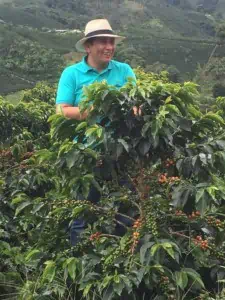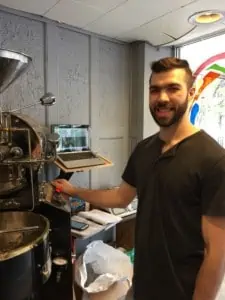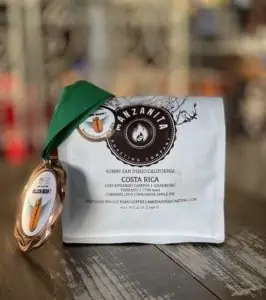I recall that, in high school, teachers graded essays based on various conventional writing categories — grammar and diction, clarity, organization, etc. But most also gave credit for originality. Often, some friend’s paper would show weaknesses in regard to comma placement, word choice, and clear organization but attract a high grade for originality.
Perhaps you could say that some of the coffees we review this month invite a similar approach to evaluation. If we look at them only using criteria we applied to coffees 10 years ago, we might find many of them rather flawed. Good body and mouthfeel, yes. Usually sweet, but often sour too: think plain yogurt or sour beer. And the aroma and flavor they display is often familiar in detail yet still wildly original in totality — tropical fruits, sweet herbs and spices, and on one occasion a very distinct, dominating collection of notes suggesting the fusion of cocoa, cinnamon and sugar that gives Mexican hot chocolate its distinction. We also had a sample that tasted a lot like gingerbread, and another remarkably like pumpkin pudding (neither is reviewed here).
The New World of Anything-Goes Processing

Rodrigo Sanchez, producer of the Old Soul Co. Colombia Monteblanco Gesha Cold Fermentation. Courtesy of Old Soul Coffee Co.
Fermentation is a tricky term with lots of technical caveats, but in the beverage world, it is usually broadly defined as the chemical breakdown of a substance by bacteria, yeasts or other microorganisms. In traditional processing of coffee by the wet or washed method, the freshly skinned or pulped fruit is put into tanks to ferment, powered by whatever yeasts and bacteria are present in the immediate environment. The goal in such traditional ferment is simply to break down and soften the sweet, sticky fruit flesh so it later can be easily washed off the beans before they are dried. Any influence on the taste of the final coffee by the ferment step was disregarded, to the point that many leading technical experts in coffee argued that the fermentation step in wet-processing is a labor-intensive tradition with no discernible impact on taste and that it should be replaced by scrubbing the sticky flesh off the beans by machines called mechanical demucilagers (as is now the practice in many places in the world).

Colläge Coffee’s Joe Funte at his Pennsylvania roastery.
The Beauty of Alcohol Ferment: The New Naturals
Meanwhile, the specialty side of the coffee world was busy heading in the other direction: It discovered the potential beauty of coffees that add a little sweet, alcohol-tending ferment to the cup through the bean being dried in the entire fruit, with the sweet fruit flesh sealed around the bean by the skin. These are the “new naturals,” carefully refined small-batch variations on the ancient practice of drying coffee in the whole fruit. These juicy, fruit-bomb coffees have erupted in popularity at the top end of the specialty market over the past few years. (See our 2010 report, Brandy and Surprises: The New Naturals.) In this case, fermentation, particularly of sugars or carbohydrates by yeasts that occurs while the fruit is drying, produces a lush sweetness, often with a hint of alcohol created by the work of the yeasts, resulting in wine-like, or brandy-like, or any number of other alcohol-associated notes. If, however, through any number of careless practices, the wrong microorganisms become involved in these processes and the fruit molds or rots, we encounter instead the unpleasant-to-repulsive notes common with cheap natural-processed coffees the world over.
The Key Wrinkle: Reduced Oxygen Fermentation
Which gets us back to this month’s experimental coffees. The details of these new experiments vary, but two constants run through them all: First, they are all complex and labor-intensive, and second, at some point the coffee is subject to fermentation with reduced oxygen (loosely called anaerobic fermentation), which encourages the formation of lactic acids (dominant in fermented foods like yogurt, kimchee, sauerkraut, sourdough bread) rather than alcohol (created by oxygen-loving yeasts and dominant in alcoholic beverages). The effort is to partly suppress the action of yeasts in the ferment, which tend to create fruity, alcohol notes, while encouraging, through reducing the availability of oxygen, the action of bacteria that create sweet-tart lactic acids.
How and Why?
Why? Apparently to create new taste profiles in coffee, to explore coffee as an art, and to create a differentiated coffee that will attract more attention and higher prices from specialty roasters. See below for our take on the success of these efforts.
How? Usually by sealing the coffee (sometimes in the whole fruit) inside tanks in which the air and its oxygen is gradually replaced by carbon dioxide, or simply by sealing it in impermeable sacks or bags. Most of the successful experiments we review here involved sealing in tanks.

Manzanita Roasting Company’s Costa Rica Anaerobic wearing the bronze medal it won at the 2019 Golden Bean North America competition. Courtesy of Manzanita Roasting.
More Detail on the How
For example, the Costa Rica Anaerobic process roasted by Colläge Coffee (93), Manzanita Coffee (93) and Black & White Coffee Roasters (93) were all produced by the same farmer from particularly ripe fruit with high sugar content. The skins were removed and the beans, still enveloped in their sugary flesh or mucilage, were sealed inside tanks, where they fermented with limited oxygen, promoting lowered yeast activity but intensified activity of lactic acid-promoting bacteria. The result, in the case of two of the samples, was complex and engaging notes we associated with chocolate, perhaps raw chocolate, plus cinnamon and an exciting array of other spices. In the Colläge sample, this flavor complex struck us as a dead ringer for the cakes used to produce Mexican chocolate that combine chocolate, sugar, vanilla and cinnamon. With the Manzanita sample, a similar engaging range of chocolate and sweet spice notes displayed. The Black & White sample showed a complex we read as a combination of dried apricot and honey, but it, like the other two samples, displayed the same pleasing complexity and sweet-savory depth. (By the way, we did not compare notes while, or even after, we tested these three coffees. We tested the samples separately on different days and generated the reviews separately. Reassuringly, the ratings came out the same and the descriptors overlapped closely in two cases.)

Jason Yu of Dory Coffee at his roaster. Courtesy of Dory Coffee.
With two other samples using lactic acid-promoting ferment, the Dory Coffee Ethiopia Anaerobic (93) and the Lucky Café Colombia Finca El Paraiso Double Anaerobic Geisha (92), the fermentation was carried out in two phases: First, the entire fruit was subjected to fermentation in a sealed container for approximately two days, then it was removed and the skins removed from beans, after which they were placed back in the sealed tanks inside their fruit flesh or mucilage for about another three days before drying. The Dory coffee showed the distinct sweet-spice tendency of the other anaerobic/lactic acid experiments but with a bit less intensity and more balance. The Lucky Café Colombia started with a green coffee from the always aromatically exciting Geisha variety of Arabica, and perhaps owing to the impact of this dynamic variety, or perhaps more to the details of the processing, it displayed a particularly wild and wide range of tastes and aromas, including musk and yogurt, notes that made sporadic appearances in other of this month’s coffees, though less prominently than here.
Apparently, the Small Eyes Café Ethiopia Yirgacheffe Adorsi (92) was sealed inside limited oxygen tanks in whole bean rather than after skin removal, making it an “anaerobic natural,” to use current nomenclature. The lactic acid influence here can be felt in the sweet yet bracingly brisk structure, as well as perfumy, musky aromatics complicated by a sort of strawberry yogurt suggestion.
The Champion of Shock and Surprise
Certainly the most startling and extreme profile among the seven experimental process coffees reviewed for this report is the top-rated Willoughby’s Panama Perci Geisha (96) generated by the relentlessly innovating Panama producer Ninety Plus Gesha Estates. Ninety Plus is quite reticent (okay, secretive) about the details of its processing experiments, but this sample projects with a particular, even disturbing intensity certain of the tendencies cited for the other experimental samples described here. Along with an explosion of pleasingly familiar aromatics (tropical fruit, dark chocolate) come a whole shelf of herb and spice, a yogurt-like lactic-acid twist to the structure, and deep, musky suggestions.
The Tricky Question of Terminology
The innovating edge of the coffee industry appears to have settled on the term “anaerobic fermentation” for the processes I’ve been describing. An alternative name proposed by others is “lactic acid fermentation,” referring to the goal of intensifying fermentation by bacteria that produce lactic acids associated with yogurts and fermented vegetable foods. Those of a technical turn of mind have objected to the term anaerobic because the tanks and bags involved do not eliminate oxygen from the process, only reduce it. In fact, they raise issues about the accuracy of the term “fermentation” to start with as it applies to coffee processing.

Tom Chuang of Small Eyes Cafe at his Taiwan-built Yang-Chia Bella Mini 500 roasting machine. Courtesy of Small Eyes Cafe.
But the language used to describe processing methods in coffee has never been distinguished by its technical rigor. “Natural,” the most widely used term for coffees dried in the whole fruit, is a case in point. For years, I tried to refer to these coffees by the explicit language “dried in the fruit,” but no one took me up on it. After all, “natural” is one word, and it’s a cool word with positive associations; furthermore, it’s an infinitely superior word to “unwashed,” the old industry term for coffees dried in the whole fruit. So if it turns out that the coffee world goes for “anaerobic,” so be it.
Out-of-Competition Standouts
Finally, we celebrate three additional fine coffees supplementing the anaerobic/lactic-acid-processed coffees focused on so far. All three of these coffees benefited from creative variations in the fermentation step, with original and engaging results, though none pushed the envelope quite as forcefully as the seven we review as part of this report.
The Old Soul Colombia Monteblanco Gesha Cold Fermentation (93) embodied a particularly interesting processing variation. Here the fruit, picked at its peak sweetness, was initially fermented in the whole fruit for three days in refrigerated tanks, aiming to complicate and deepen the sensory character of the coffee by slowing down the chemical changes associated with the early stages of processing. In this case, the result seemed to emphasize the deeply sweet yet brisk, complexly savory side of the Gesha profile.
The fine Coffeebar Sidama Naia Bombe Dry Ferment (93) added no water to the fermentation tank and applied other refinements to the drying stage to encourage a particularly spicy floral character and a tart yet juicy structure. Finally, the 94 Fresh Coffee Costa Rica Brunca Finca Vista Passion Honey (93) employed refinements to the drying stage of the honey process (beans are dried with the skins removed but the fruit flesh still enveloping them) to promote a very delicate, chocolaty alcohol ferment balanced by zesty lime.
More on the Way
Clearly, we will be seeing more producers pushing the envelope in regard to processing methods, particularly through the creative use of fermentation during the interval between picking and drying. The results of the more radical of these experiments will likely continue to impress lovers of change and excitement while helping us all better understand our favorite beverage and its expressive potential.










